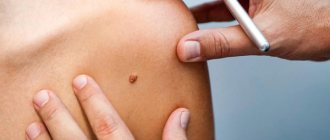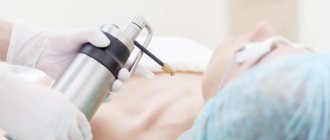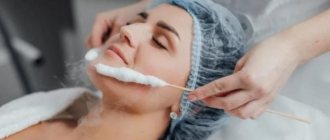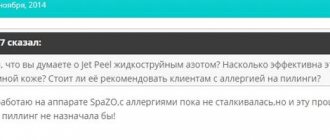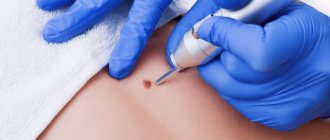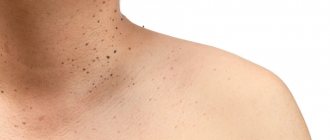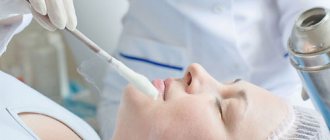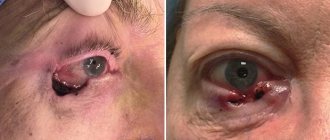Author
Kulova Zhanna Borisovna
Head of the Center for Cosmetology and Preventive Medicine
Cosmetologist
until January 31
We are giving away 1000 rubles for all services for a visit in January More details All promotions
Cryodestruction is a method of removing tumors on the skin, which is based on the use of liquid nitrogen. Often considered as a tool in aesthetic cosmetology and dermatology, allowing you to get rid of:
- warts;
- papillomas;
- condylomas;
- keratome;
- hemangiomas;
- unwanted moles (nevi).
This method is successfully used in other branches of medicine - gynecology, surgery, oncology. The method of cryodestruction successfully removes tonsils and treats cervical erosion. Using endoscopic methods, doctors have learned to use cryodestruction to combat tumors of internal organs.
Removal of tumors with liquid nitrogen: main advantages
The main advantage of this method is its low invasiveness. After the destruction of the tumor, a crust forms on the skin, under which the healing process is actively underway. Soon the crust falls off, leaving no trace. There is practically no bleeding or pain during this procedure; there is no need for special preparation or anesthesia.
The benefits of using liquid nitrogen include:
- rapidity;
- short recovery period;
- no need for special care of the treated skin area;
- affordable prices for cryodestruction procedures.
It is also important that various moles, papillomas or warts, regardless of their nature, can be treated equally effectively. Therefore, if you decide to remove a skin tumor by cryodestruction, you can count on a positive result after the first session.
Treatment methods
Depending on the severity of the problem and individual contraindications, plantar tumors are removed in different ways:
- electrocoagulation with high-frequency current;
- cryodestruction with liquid nitrogen;
- surgery;
- conservative drug therapy;
- radio wave exposure;
- laser technique.
Laser removal is recognized as the most effective and safe in modern medicine. Light radiation burns damaged tissue without injuring nearby ones. At the same time, neighboring cells are “sterilized,” which eliminates the risk of re-formation of plantar warts. The non-invasive, non-contact method eliminates the possibility of infection, does not cause discomfort, and has a short rehabilitation period. Another advantage of the laser is a reduced list of contraindications. The technique is also used in patients with insufficient blood clotting, a tendency to allergies, weakened immunity, and impaired metabolism.
Laser removal of warts on the elbow. Wart removal in progress. No traces remain
Laser removal of warts on the finger. Removing warts on hands with laser. Fast and painless.
Laser removal of multiple warts on the hand. Laser removal of warts
How is papillomas removed by cryodestruction?
A few seconds of exposure to liquid nitrogen is enough for the neoplasm to collapse
Using the example of papilloma, we will look at how the procedure for removing a tumor with liquid nitrogen is carried out. The process can be divided into the following stages:
1. Freezing papilloma. Using a special device or miniature applicator, the doctor applies liquid nitrogen with a temperature of –195.7 degrees Celsius to the tumor.
2. Necrosis of papilloma. Under the influence of liquid nitrogen, the pathological area turns pale, the patient begins to feel a slight tingling: this is the crystallization of the cytoplasm in the neoplasm cells, which damages their membranes. The time allotted for the procedure (from 5 to 30 seconds) is quite enough to cause irreparable damage to the papilloma.
3. Restoration of blood circulation. Within a few hours after the procedure, the area of skin where the papilloma was located turns red and swells.
4. Complete necrosis of papilloma. The process takes from 2 weeks to 2 months. From the neoplasm itself, only a crust remains, and healthy, smooth tissue forms under it.
5. Recovery. After a maximum of six months, there will be no traces left on the skin.
If the papilloma was large enough, the procedure may need to be repeated. In this case, only a doctor can give the exact timing of the final solution to the problem.
If after cryotherapy a bubble with liquid appears at the site of the tumor, it is not recommended to pierce it. It is better to treat the skin area with an antiseptic until this bubble disappears naturally, or consult a dermatologist for advice.
Cost of the procedure
The cost of removing warts with liquid nitrogen is determined by the number of growths on the skin. Sometimes it is necessary to conduct several cryodestruction sessions, which increases the total cost of treatment.
At the Healthy Family clinic, you can remove warts with liquid nitrogen in Moscow. Experienced specialists work with patients, observing infection safety rules. We provide comprehensive and consistently high-quality medical care.
See also:
Cryodestruction
Facial cryomassage
Cryodestruction of tonsils
Indications and contraindications for cryodestruction
As a rule, patients decide to remove skin tumors wanting to get rid of cosmetic defects. First of all, it is recommended to remove moles and warts located in “unsuccessful” areas where they are regularly injured.
There are practically no contraindications to cryotherapy: it is recommended even for children, if necessary. But there are cases when it does not give the desired effect, for example, if the diameter of the tumor exceeds 4 mm.
It is better to refrain from cryodestruction during infectious and inflammatory processes until they are cured.
Make an appointment Do not self-medicate. Contact our specialists who will correctly diagnose and prescribe treatment.
Radio wave removal of warts
The technology gives the surgeon the opportunity to cut out the tumor literally “at the root.” It is used to remove the following types of warts:
- flat,
- plantar,
- speakers.
- hanging.
In addition, the method is suitable for removing genital warts. The procedure itself takes 10-20 minutes and is almost bloodless. To numb the area being treated, the doctor uses local injection anesthesia or a superficial application of a special cream. To remove the growth, a specialized device is used - Surgitron, also known as a radio knife. It has a gentle effect on the problem area of the skin without affecting healthy tissue, without irritating nerves or causing muscle contractions.
The main advantage of the radio wave method is minimal trauma, since radio waves practically do not affect surrounding tissues. The risk of inflammation and complications is also minimal.
3.How does it work and what are the risks?
How it works?
Cryotherapy will help remove warts, but the virus itself may remain, so additional treatments may be required.
What are the risks of cryotherapy?
If the wart is thick and requires extensive cryotherapy, the nerves around it may be damaged, scar tissue may form, and healing may take longer.
There is a small chance of infection during wart removal with nitrogen. Signs of infection include:
- Increased pain, redness, swelling;
- Purulent discharge;
- Heat.
About our clinic Chistye Prudy metro station Medintercom page!
Possible complications after cauterizing warts with liquid nitrogen
As a rule, after cauterization of papillomas with liquid nitrogen, the risk of postoperative complications is minimal. However, if contraindications are ignored, cryodestruction technology is not followed, or the doctor’s instructions are not followed during the rehabilitation period, the following adverse side effects may occur:
- Allergic reaction to cold exposure;
- Bacterial contamination of a postoperative wound and spread of infection;
- Damage to healthy tissues as a result of incorrect choice of intensity and depth of exposure;
- The appearance of pigment spots at the site of the removed wart;
- Formation of scars.
Removing warts (the price of the procedure will depend on the location, number and size of papillomas) using liquid nitrogen is one of the effective and popular methods of combating skin formations. You can perform high-quality and successful cauterization of warts with nitrogen in our specialized clinic. We employ experienced and highly qualified specialists who will perform surgical and professional excision of pathological neoplasms of any size and location.
Attention!
This article is posted for informational purposes only and under no circumstances constitutes scientific material or medical advice and should not serve as a substitute for an in-person consultation with a professional physician.
For diagnostics, diagnosis and treatment, contact qualified doctors! Number of reads: 1296 Date of publication: 09/29/2018
Dermatologists - search service and appointment with dermatologists in Moscow
What are the most common warts?
Most often (up to 70% of all cases), patients report warts that bother them, and the majority of patients are school-age children. Warts are also found in 20% of students. Plantar warts are more common in adults (34% of cases), as opposed to flat warts, which are again more common in children (4% of all warts).
An experienced dermatologist can easily determine the type of wart during a consultation. However, in rare cases, especially if the wart is injured, it is difficult to diagnose it only by examination, and then the doctor can perform a biopsy of the derivative and histological examination.
Surgical removal of warts
Plantar warts are most often removed surgically. As a rule, they are a benign neoplasm, saturated with blood vessels. In its structure, such a growth usually resembles cauliflower. Sometimes it can grow into the skin, causing pain when walking and rubbing against shoes. Plantar warts most often become a source of spread of the human papillomavirus.
The surgical method is used only if conservative therapy is ineffective. First, the doctor takes a test for histology and gives a tetanus vaccination. The operation itself includes the following steps:
- Treating the sole with soapy water.
- Separation of the hyperkeratosis covering the wart in order to determine its contours.
- Skin treatment with povidone-iodine.
- Local anesthesia with mepivacaine (2%) or another drug without the use of vasoconstrictors.
- Light massage with gauze to quickly spread the anesthetic.
- A skin incision and complete excision of the pathological growth.
- Cleaning the cut area using a Jansen spoon.
- After stopping the bleeding, clean the wound with saline solution.
- Treatment of the area with povidone-iodine, followed by application of a bandage.
After the procedure, the patient should try to keep the operated limb in an elevated position. Relative rest is recommended for 48 hours after surgery. During this time, it is necessary to avoid open sources of heat and, if necessary, take painkillers.
After 48 hours, the first dressing is done, during which the dried blood is removed with a scalpel, and the wound is washed with saline solution under pressure. After this, an enzymatic ointment is applied to the treated area, which is covered with polyethylene on top. Using shoes with an orthopedic insole, the patient can already lean slightly on the operated leg.
